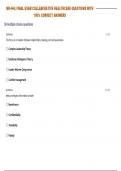Tentamen (uitwerkingen)
Cardiology Nursing 1 Humber Final exam |302 questions and answers(including diagrams).
- Instelling
- American Real Estate Academy
sinus rhythm regular rhythm Set by SA node at 60 to 100 bpm P waves normal normal qrs PR 0.12 - 0.2 normal qrs less than 0.10 wide qrs is greater than 0.12 Sinus Tachycardia 100-160 bpm SA node reduced time for ventricle filling assess for SOB or chest pain a prolonged QT ...
[Meer zien]












